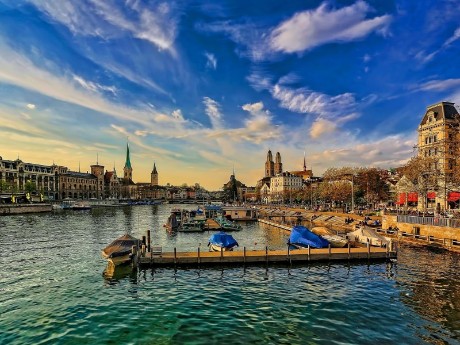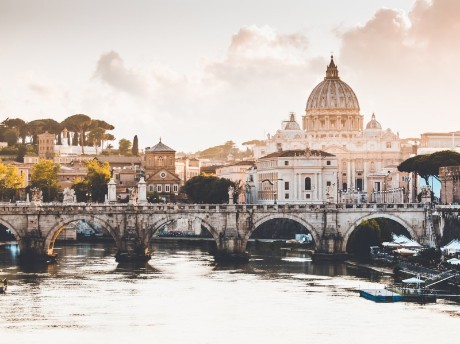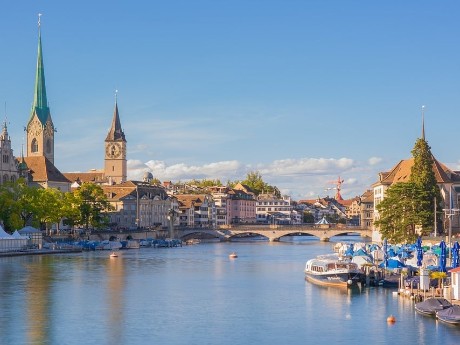VIP/Exclusive Switzerland & Italy: Zurich and Rome
Discover ancient architecture, indulge in delicious meals and explore historic sites on your multi-country trip to Switzerland and Italy. Start your journey in Zurich, the largest city in Switzerland. Art enthusiasts will enjoy the outstanding museums such as Kunsthaus Zurich while shopaholics will find paradise at Bahnhofstrasse. For those more intuned with nature, take a boat cruise tour or visit Switzerland's many lakes and waterfalls, such as Rhine Falls.
Read more
Discover ancient architecture, indulge in delicious meals and explore historic sites on your multi-country trip to Switzerland and Italy. Start your journey in Zurich, the largest city in Switzerland. Art enthusiasts will enjoy the outstanding museums such as Kunsthaus Zurich while shopaholics will find paradise at Bahnhofstrasse. For those more intuned with nature, take a boat cruise tour or visit Switzerland's many lakes and waterfalls, such as Rhine Falls. After having divine chocolates in Zurich, your journey continues to Italy. When in Rome, take a stroll through the historic centre of the city and visit the famous Spanish Steps, the Pantheon, and Trevi Fountain. Marvel at the breathtaking views from the top of the Vatican City, the smallest independent state in the world, and explore the Colosseum, the largest amphitheatre ever built to imagine what life was like during the gladiatorial games. Enjoy world class cuisine, art, history, and beauty on this tour of culture and discovery. Waterviews strives to offer accommodation options within walking distance of water and/or in an area of touristic interest. Our prices include taxes (but excludes local tourist taxes). Customize your trip to your personal preferences with optional activities (hit the “Add Activities’’) or change hotels, etc. Contact us for customization at no extra cost at: Service@waterviewstravel.com
Destinations
- Zurich
- Rome
Itinerary
Zurich

Although known worldwide as a centre for banking and finance, Switzerland’s largest city has a lot more to offer; its picturesque setting between a lake and a river with the glorious peaks of the Alps in the distance is instantly mesmerising, and the winding cobbled lanes of the old town are filled with intact medieval churches, squares and quaint cafes. Yet despite its rich history, Zürich has a contemporary, vibrant and post-industrial feel and has become a European hub for art, culture and innovation.
Read more
Although known worldwide as a centre for banking and finance, Switzerland’s largest city has a lot more to offer; its picturesque setting between a lake and a river with the glorious peaks of the Alps in the distance is instantly mesmerising, and the winding cobbled lanes of the old town are filled with intact medieval churches, squares and quaint cafes. Yet despite its rich history, Zürich has a contemporary, vibrant and post-industrial feel and has become a European hub for art, culture and innovation.
Additional Information
Zurich is Switzerland's biggest city and a cultural center of German-speaking Switzerland. Despite it not being the administrative capital of any more than its Kanton, Zurich punches well above its weight in terms of major media and business headquarters and due to it being at the heart of Switzerland's excessively punctual and meticulously maintained train network and being home to Switzerland's most important airport, it is often the first part of Switzerland that visitors get to see. Zurich is close to some excellent skiing resorts and many people headed for the Swiss Alps don't spend much time in Zurich itself, but you'd be missing a lot if you don't stay in Zurich for a couple of days at least.
While Zurich can be expensive, it is also clean, efficient and blessed with a high standard of living, which together with the high wages, explains why people bear with the high prices. Zurich has drawn people from the rest of Switzerland for centuries, but in the 20th and 21st century it has also begun to draw both people and companies from outside Switzerland and in some cases even outside Europe. This means that you will hear a lot more languages than just Swiss German and the overall atmosphere is a lot more cosmopolitan than you might think.
Zurich is home to ETH Zurich, one of the world's leading technical universities, which has produced a number of Nobel laureates and numerous innovations and due to Switzerland's long history of neutrality it also houses headquarters of the likes of FIFA or the International Ice Hockey Federation. Zurich is also home to a number of large banking and insurance conglomerates that grew on the fabled Swiss banking secret and still enjoy good reputations in the financial sector.
History
The city's Latin name, Turicum, was used for a Roman customs station at the Limmat, which has some remnants today. The Alemanni, a Germanic tribe, settled in the 5th century.
While the Church used to rule early Medieval Zurich, the Guilds (Zünfte) took power in 1336, establishing Zurich as an autonomous republic. The Guilds have survived until today, though their role today is mostly ceremonial. Zurich became the fifth canton of the Swiss Confederacy in 1351, and has been its capital at times. However, Switzerland's famous neutrality and stability is a modern thing, as many battles have been fought in and around Zurich. The canton lost the Old Zürich War between 1440 and 1446 against the confederacy, and was re-admitted in 1450.
Ulrich Zwingli led the Protestant Reformation in Switzerland during the early 16th century. As the Thirty Years War ended in 1648, the Holy Roman Empire lost its grip on Switzerland, which has mostly been independent since then.
The 1830s and 40s saw a series of revolts and war, including the Züriputsch, a revolt of conservative landowners of the canton, against the city of Zurich, and the 1847 Sonderbund War. In 1848 Switzerland adopted a constitution, which established the country as a federal republic. While the government settled in Bern, many federal institutions, including the new Polytechnic University (ETH) have their seat in Zurich.
The Zurich Stock Exchange was founded in 1877, and the city rose as a financial centre in the 20th century, as Switzerland remained neutral in the World Wars, and could maintain lower taxes on capital than the European great powers. Even though Switzerland has opted out of NATO and the European Union, Zurich is today one of central Europe's most cosmopolitan cities.
Climate
Zurich has a four-season climate typical to central Europe. Temperature in winter is usually around zero degrees, which means that snow can linger or melt away. Summers are warm with temperature in the 20s and occasionally in the 30s. The nearby mountains are significantly colder than in the valley, with snow remaining well into spring.
© Sourced from Wikivoyage
Rome

From the ancient walls of the Colosseum and the magic of the Trevi Fountain to the gilded churches of the Vatican City and the views from its seven hills, Rome is truly a dream. Stroll through the vibrant streets and you’ll get a taste for the city’s incredible past and rich culture, with ancient churches, Roman ruins and opulent fountains on every corner. And the city not only offers sightseeing - do as the locals and meander in piazzas, sample incredible street food and stop for an evening aperitivo to really experience la dolce vita.
Read more
From the ancient walls of the Colosseum and the magic of the Trevi Fountain to the gilded churches of the Vatican City and the views from its seven hills, Rome is truly a dream. Stroll through the vibrant streets and you’ll get a taste for the city’s incredible past and rich culture, with ancient churches, Roman ruins and opulent fountains on every corner. And the city not only offers sightseeing - do as the locals and meander in piazzas, sample incredible street food and stop for an evening aperitivo to really experience la dolce vita.
Additional Information
Situated on the River Tiber, between the Apennine Mountains and the Tyrrhenian Sea, the "Eternal City" was once the administrative centre of the mighty Roman Empire, governing a vast region that stretched all the way from Britain to Mesopotamia. Today it remains the seat of the Italian government and home to numerous ministerial offices. Rome has 2.7 million inhabitants while the metropolitan area is home to around 4.5 million.
Architecturally and culturally, Rome has some contrasts - you have areas with pompously huge majestic palaces, avenues and basilicas, which are then surrounded by tiny alleyways, little churches and old houses. The centre of Rome is mainly ancient, and modern buildings are usually concentrated in the suburbs, unlike Milan (where new and old architecture is combined both in the centre and the outskirts). You may also find yourself walking from a grand palace and tree-lined elegant boulevard, into a small and cramped Medieval-like street.
The abbreviation "S.P.Q.R" is ubiquitous in Rome, short for the old democratic motto "Senatus Populusque Romanus" (Latin), i.e. "The Roman Senate and People".
For two weeks in August, many of Rome's inhabitants shut up shop (literally) and go on their own vacations; many stores, restaurants and other amenities will be closed during this time. The temperature in the city centre at this time of year is not particularly pleasant. If you do travel to Rome at this time, be prepared to see Chiuso per ferie (Closed for holidays) signs on many establishments. Even in these weeks the city is very beautiful and if you are looking for a less overcrowded vacation in Rome, this is not a bad time. You will always be able to find somewhere to eat.
History
Rome's history spans over two and half thousand years, which have seen its transformation from a small Latin village to the centre of a vast empire, through the founding of Catholicism, and into the capital of today's Italy. Rome's history is long and complex. What follows is merely a quick summary.
Rome is traditionally thought to have been founded by the mythical twins Romulus and Remus, who were abandoned as infants in the Tiber River and raised by a mother wolf before being found by a shepherd who raised them as his own sons. Rome was founded as a small village sometime in the 8th century BC surrounding the Palatine Hill, including the area where the Roman Forum is found. Due to the village's position at a ford on the Tiber River, Rome became a crossroads of traffic and trade.
The settlement developed into the capital of the Roman Kingdom, led by a series of Etruscan kings, before becoming the seat of the Roman Republic at around 500 BC, and then the centre of the Roman Empire from 27 BC on. For almost a thousand years, Rome was the largest, wealthiest, most powerful city in the Western World, with dominance over most of Europe and the Mediterranean Sea. Even after the fall of the Roman Empire in the 5th century AD, Rome maintained considerable importance and wealth.
Beginning with the reign of Constantine I, the Bishop of Rome (later known as the Pope) gained political and religious importance, establishing Rome as the centre of the Catholic Church. During the Early Middle Ages, the city declined in population but gained a new importance as the capital of the newly formed Papal States. Throughout the Middle Ages, Rome was a major pilgrimage site and the focus of struggles between the Holy Roman Empire and the Papacy.
With the Italian Renaissance fully under way in the 15th century, Rome changed dramatically. Extravagant churches, bridges, and public spaces, including a new Saint Peter's Basilica and the Sistine Chapel, were constructed by the Papacy so that Rome would equal the grandeur of other Italian cities of the period. As the Grand Tour became customary for young European gentlemen in the 17th century, Rome became an important tourist destination, and remains as such until today.
In the 19th century, Rome again became the focus of a power struggle with the rise of the Kingdom of Italy, which wished to see a reunification of Italy. The Papal States remained in control of Rome under French protection, but with the outbreak of the Franco-Prussian War of 1870, French troops were forced to abandon Rome, leaving it clear for the Kingdom of Italy to capture. Rome became the capital of Italy, and has remained such ever since.
Rome today is a contemporary metropolis that reflects the many periods of its long history - Ancient times, Middle Ages, the Renaissance and the Modern Era. With the rise of Italian Fascism following World War I, Rome's population grew. This trend was stopped by World War II, which dealt relatively minor damage to Rome. With the dismantlement of the monarchy and the creation of the Italian Republic following WWII, Rome again began to grow in population and became a modern city. The city stands today as the capital of Italy and one of the world's major tourist destinations.
Climate
Rome has a Mediterranean climate, with hot, dry summers and mild, wet winters. In the winter months, daytime temperatures are usually pleasant and range from 10-15 °C, while nighttime temperatures tend to stay slightly above freezing. That being said, the occasional cold snap can cause temperatures to fall below freezing, and it is not unheard of for light flurries of snow to fall on occasion, though accumulation is rare, and major snowstorms are known to occur once every 20-25 years.
Background reading
At last count there were close to 1700 novels set in Rome in days gone by. Most easily available in bookshops are those by [http://lindseydavis.co.uk/ Lindsey Davis and Steven Saylor. Both are good storytellers and excellent at portraying life in Ancient Rome. Particularly interesting if you are visiting Rome may be Saylor’s Roma: The Novel of Ancient Rome, which traces the first thousand years or so of Rome’s history by following the fictional fortunes of two families. Each chapter begins with a map showing the state of Rome’s development at the time of the chapter.
The classic work on Ancient Rome remains Edward Gibbon’s History of the Decline and Fall of the Roman Empire. This was written in 1782 but is still being reprinted. A marvelous book that covers Rome’s fortunes from Romulus and Remus to the 1970s is Rome: The Biography of a City by Christopher Hibbert (Penguin). An excellent guide book, too, although perhaps a bit too heavy to carry around. Rome by Robert Hughes (Orion Books) concentrates on the city's art history and provides fascinating insights into the things you will see while walking around. SPQR, written by Cambridge University professor and British TV personality Mary Beard, and published in 2015, offers a detailed analysis of Rome's first 1000 years and attempts to answer why Rome expanded from a small village on the Tiber to the centre of a major empire.
English-language bookshops in Rome are: The Lion Bookshop, Via dei Greci, 36, close to Piazza di Spagna. Lots of books and a small cafe. Anglo-American Bookstore, Via delle Vite, 102, also close to Piazza di Spagna. A large store, with specialist sections. Strong on non-fiction. The Almost Corner Bookshop, Via del Moro 45, Trastevere. Small but very well-stocked store on the other side of the river. Some Italian bookstores also have English-language sections. Try the large selection of English books (but also French, Spanish and more) at Feltrinelli International in via Vittorio Emanuele Orlando - or the smaller selection at its store in Largo Argentina.
© Sourced from Wikivoyage





